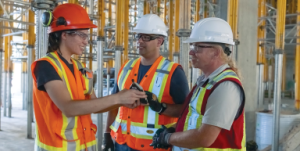
© WorkSafeBC (Workers’ Compensation Board), used with permission
WorkSafeBC guideline addresses the issue of ill-fitting PPE, which can compromise worker safety
By WorkSafeBC
Personal protective equipment (PPE) has protection built into its name. But when PPE isn’t designed for every body, shape, and size, it can become both a barrier for entry into the construction industry and, more importantly, safety.
A report into the experiences of women in the trades identified that many women listed PPE as one of the top systemic barriers they face when entering the industry. More than 80 percent of women described experiencing one or more problems with their PPE, including discomfort, reduced mobility, and safety due to issues with size, fit, and selection.
From not being able to use a washroom to excess fabric causing tripping hazards or catching or snagging on equipment, ill-fitting PPE can increase a worker’s risk of injury and illness, as well as have an impact on their comfort and psychological safety.
“We recognize that the differences in body shape and size between workers can make it challenging to find PPE that fits properly,” says Suzana Prpic, Prevention Field Services at WorkSafeBC. “We want to make sure that all workers are protected and comfortable while on the job, and that means ensuring PPE is designed and fitted to accommodate a wide range of body types.”
Ensuring adequate fit for PPE
In November 2022, WorkSafeBC introduced guideline G8.3, Ensuring adequate fit of personal protective equipment in association with section 8.3(1) of the Occupational Health and Safety (OHS) Regulation. The guideline speaks to the general requirement for employers to equip workers with PPE that provides effective protection to workers and does not in itself create a hazard to the wearer.
The guideline outlines the requirements for the design, selection, and use of PPE that is appropriate for all workers, and includes specific guidance on how to measure and fit PPE to a wide range of body types.
In addition to ensuring employers provide properly fitting PPE for all body shapes and sizes, Prpic says, employers should stock sizing charts and fitting samples from suppliers for workers to try
- She adds employers could also consider offering alteration services to ensure PPE can be tailored to fit every body type properly. Providing options shows workers they are valued and respected, which in turn, improves recruitment and retention.
Advocating for inclusive PPE
Since implementing the guideline in 2022, WorkSafeBC has engaged with PPE manufacturers and conducted research studies to better understand the PPE currently available to B.C. workers and where the gaps are, especially for women. This engagement and research included exploring inclusive PPE design and identifying barriers to employer uptake of properly fitting options for women.
“PPE is the last line of protection,” says Prpic. “It’s important for employers to engage workers in discussions about any PPE concerns, and I hope that workers speak up to their supervisors when PPE doesn’t fit properly.”
Workplace health and safety culture, proactive health and safety management — including reviewing PPE requirements for women — and health and safety performance are all connected. If you are a worker with questions or concerns about accessing PPE, have a conversation with your employer or supervisor. Building a strong health and safety culture benefits everyone.
We’re here to help
A healthy and safe workplace is a shared responsibility. For inquiries about health and safety, call the WorkSafeBC Prevention Information Line at 1.888.621.7233.
To find resources and learn more about your responsibilities when it comes to PPE, visit worksafebc.com.

